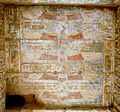| Nekhbet | |||||||
|---|---|---|---|---|---|---|---|
 Illustration of Nekhbet with outstretched wings wearing an Atef crown and holding both shen rings and plumed scepters, based on depictions from antiquity. Illustration of Nekhbet with outstretched wings wearing an Atef crown and holding both shen rings and plumed scepters, based on depictions from antiquity. | |||||||
| Name in hieroglyphs |
| ||||||
| Major cult center | Nekheb | ||||||
| Symbol | Vulture | ||||||
Nekhbet (/ˈnɛkˌbɛt/; also spelt Nekhebit) is an early predynastic local goddess in Egyptian mythology, who was the patron of the city of Nekheb (her name meaning of Nekheb). Ultimately, she became the patron of Upper Egypt and one of the two patron deities (alongside Wadjet) for all of Ancient Egypt when it was unified.
Mythology
One of Egypt's earliest temples was the shrine of Nekhbet at Nekheb (also referred to as El Kab). It was the companion city to Nekhen, the religious and political capital of Upper Egypt, at the end of the Predynastic period (c. 3200–3100 BC) and probably, also during the Early Dynastic Period (c. 3100–2686 BC). The original settlement on the Nekhen site dates from Naqada I or the late Badarian cultures. At its height, from about 3400 BC, Nekhen had at least 5,000 and possibly as many as 10,000 inhabitants.
Nekhbet was the tutelary deity of Upper Egypt. Nekhbet and her Lower Egyptian counterpart Wadjet often appeared together as the "Two Ladies". One of the titles of each ruler was the Nebty name, which began with the hieroglyphs for of the Two Ladies....
Iconography


In art, Nekhbet was depicted as a vulture. Alan Gardiner identified the species that was used in divine iconography as a griffon vulture. Arielle P. Kozloff, however, argues that the vultures in New Kingdom art, with their blue-tipped beaks and loose skin, better resemble the lappet-faced vulture.
In New Kingdom times, the vulture appeared alongside the uraeus on the headdresses with which kings were buried. The uraeus and vulture are traditionally interpreted as Wadjet and Nekhbet, but Edna R. Russmann has suggested that in this context they represent Isis and Nephthys, two major funerary goddesses, instead.
Nekhbet usually was depicted hovering, with her wings spread above the royal image, clutching a shen symbol (representing eternal encircling protection), frequently in her claws.
Depictions of animal deities start with the animal being depicted directly. Later the animal appears in human form, but still with an animal head. Individual deities continue into historical times (post 3000 BC) to often be described in their original animal form: e.g., Horus (Falcon), Wadjet (cobra) and Nekhbet (vulture).
Gallery
-
 Nekhbet with outstretched wings below a row of uraei, from the mortuary temple of Hatshepsut, Deir el-Bahari
Nekhbet with outstretched wings below a row of uraei, from the mortuary temple of Hatshepsut, Deir el-Bahari
-
 Granite statue of Nekhbet from Sanam in Lower Nubia, Twenty-fifth Dynasty, Ashmolean Museum
Granite statue of Nekhbet from Sanam in Lower Nubia, Twenty-fifth Dynasty, Ashmolean Museum
-
 Paintings of Nekhbet on the ceiling of the mortuary temple of Ramesses III at Medinet Habu
Paintings of Nekhbet on the ceiling of the mortuary temple of Ramesses III at Medinet Habu
-
Nekhbet above the Nomen and prenomen of Ramesses III
-
 Nekhbet next to Haremakhet on a column
Nekhbet next to Haremakhet on a column
-
 A painted relief depicting Nekhbet in the Temple of Hatshepsut
A painted relief depicting Nekhbet in the Temple of Hatshepsut
-
 Nekhbet holding a staff and Shen ring
Nekhbet holding a staff and Shen ring
-
 A painted relief depicting Nekhbet in Queen Hatshepsut's temple
A painted relief depicting Nekhbet in Queen Hatshepsut's temple
-
 Relief from the Temple of Nekhbet at El Kab
Relief from the Temple of Nekhbet at El Kab
-
 Nekhbet (right) and Wadjet (left) crowning Ptolemy VIII in the Temple of Edfu
Nekhbet (right) and Wadjet (left) crowning Ptolemy VIII in the Temple of Edfu
In popular culture
- Nekhbet is a bird-like monster in Final Fantasy XII.
- Nekhbet appears in Rick Riordan's The Throne of Fire as a minor antagonist.
- Nekhbet is the name of a pet vulture in the anime Tenshi ni Narumon.
- Nekhbet is an ascending goddess in the Dungeon Crawler Carl series.
References
- "Nekhbet". Dictionary.com. Random House. 2012.
- ^ Wilkinson, Richard H. (2003). The Complete Gods and Goddesses of Ancient Egypt. Thames & Hudson. pp. 213–214
- Bailleul-LeSuer, Rozenn (ed), Between Heaven and Earth: Birds in Ancient Egypt. The Oriental Institute of the University of Chicago. pp. 61–62, 138
- Robins, Gay, Review of The Animal World of the Pharaohs and Choice Cuts: Meat Production in Ancient Egypt. Journal of the American Oriental Society, vol. 119, no. 1, (January–March 1999)
- Christiansen, S. U.2023 What do the Figurines of ”Bird Ladies” in Predynastic Egypt represent? (OAJAA)
Further reading
- Hans Bonnet: Nechbet. In: Lexikon der ägyptischen Religionsgeschichte. Nikol, Hamburg 2000, ISBN 3-937872-08-6, S. 507f.
- Wolfgang Helck, Eberhard Otto: Nechbet. In: Kleines Lexikon der Ägyptologie. Harrassowitz, Wiesbaden 1999, ISBN 3-447-04027-0, S. 199.
- Alexandra von Lieven: Grundriss des Laufes der Sterne – Das sogenannte Nutbuch. The Carsten Niebuhr Institute of Ancient Eastern Studies (u. a.), Kopenhagen 2007, ISBN 978-87-635-0406-5.
- Alexandra von Lieven: Der Himmel über Esna – Eine Fallstudie zur religiösen Astronomie in Ägypten am Beispiel der kosmologischen Decken- und Architravinschriften im Tempel von Esna. Harrassowitz, Wiesbaden 2000, ISBN 3-447-04324-5.
- Marcelle Werbrouck, Fouilles de El Kab II. 1940, S. 46ff.
| Ancient Egyptian religion | |||||||||
|---|---|---|---|---|---|---|---|---|---|
| Beliefs |  | ||||||||
| Practices | |||||||||
| Deities (list) |
| ||||||||
| Creatures | |||||||||
| Characters | |||||||||
| Locations | |||||||||
| Symbols and objects |
| ||||||||
| Writings |
| ||||||||
| Festivals | |||||||||
| Related religions | |||||||||